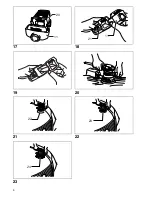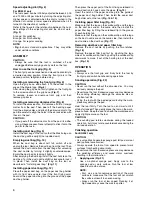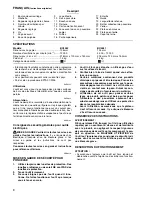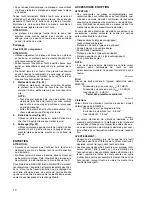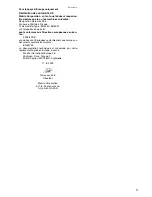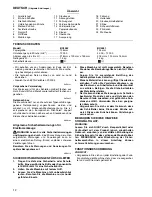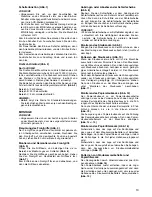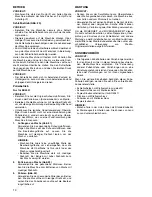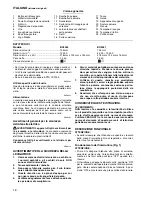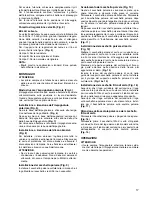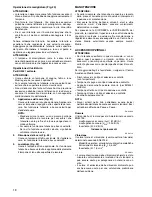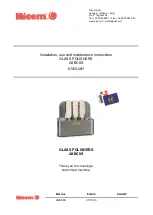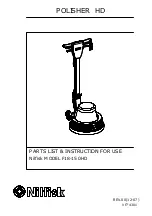
6
Speed adjusting dial (Fig. 2)
For BO5041 only
The tool speed can be infinitely adjusted between 4,000
and 12,000 orbit per minute by turning the adjusting dial.
Higher speed is obtained when the dial is turned in the
direction of number 5; lower speed is obtained when it is
turned in the direction of number 1.
Refer to the figure for the relationship between the num-
ber settings on the adjusting dial and the kind of work.
(Fig. 3)
A range: For polishing
B range: For finish sanding
C range: For regular sanding
NOTE:
•
Fig. 3
shows standard applications. They may differ
under certain conditions.
ASSEMBLY
CAUTION:
• Always be sure that the tool is switched off and
unplugged before carrying out any work on the tool.
How to use the front grip (Fig. 4)
The front grip can be loosened and moved horizontally to
a desired working position. Once the front grip is in the
desired position, retighten before using.
Installing or removing the front grip (Fig. 5)
Open the grip base, and attach it to the sander in the
area of the Makita logo.
(Fig. 6)
After closing the grip base, firmly tighten on the front grip
to the screw section of the grip base.
(Fig. 7)
To remove, loosen and remove front grip, and then
remove grip base.
Installing or removing abrasive disc (Fig. 8)
To install the abrasive disc, first remove all dirt or foreign
matter from the pad. Then peel off the backing paper
from the abrasive disc and attach the abrasive disc to the
pad. Be careful to align the holes in the abrasive disc with
those in the pad.
CAUTION:
• If you peel off the abrasive disc from the pad, its adhe-
sion will become poor. Never attempt to stick it onto the
pad for further use.
Installing dust bag (Fig. 9)
Install the dust bag on the tool so that the Makita logo on
the dust bag will be upright (not upside down).
Emptying dust bag (Fig. 10)
When the dust bag is about half full, switch off and
unplug the tool. Remove the dust bag from the tool. Then
remove the dust nozzle from the dust bag after unlocking
the dust nozzle by turning it slightly counterclockwise.
Empty the dust bag by tapping it lightly.
After emptying the dust bag, install the dust nozzle on the
dust bag. Turn the dust nozzle slightly clockwise to lock it
in place. Then install the dust bag on the tool as
described in “Installing dust bag”.
(Fig. 11)
Installing paper dust bag (Fig. 12)
Place the paper dust bag on the paper dust bag holder
with its front side upward. Insert the front fixing card-
board of the paper dust bag into the groove of the paper
dust bag holder.
Then press the upper part of the front fixing cardboard in
arrow direction to hook it onto the claws.
(Fig. 13)
Insert the notch of the paper dust bag into the guide of
the paper dust bag holder. Then install the paper dust
bag holder set on the tool.
(Fig. 14 & 15)
Installing paper filter bag (Fig. 16)
Make sure that the logo on the cardboard lip and the logo
on the dust box are on the same side, then install the
paper filter bag by fitting the cardboard lip in the groove
of each holding tab.
Make sure that the logo on the cardboard lip and the logo
on the dust nozzle are on the same side, then install the
dust nozzle on the dust box.
(Fig. 17)
Removing dust box and paper filter bag
Remove the dust nozzle by pushing the two latches.
(Fig. 18)
Remove the paper filter bag first by pinching the logo
side of its cardboard lip, then by pulling the cardboard lip
downwards to move it out of the holding tab of the dust
box.
(Fig. 19)
OPERATION
CAUTION:
• Always use the front grip and firmly hold the tool by
front grip and switch handle during operations.
Sanding operation (Fig. 20)
CAUTION:
• Never run the tool without the abrasive disc. You may
seriously damage the pad.
• Never force the tool. Excessive pressure may decrease
the sanding efficiency, damage the abrasive disc or
shorten tool life.
• Using the tool with the pad edge contacting the work-
piece may damage the pad.
Hold the tool firmly. Turn the tool on and wait until it
attains full speed. Then gently place the tool on the work-
piece surface. Keep the pad flush with the workpiece and
apply slight pressure on the tool.
CAUTION:
• The sanding pad rotates clockwise during the loaded
operation, but it may rotate counterclockwise during the
no-load operation.
Polishing operation
For BO5041 only
CAUTION:
• Use only a Makita genuine sponge pad, felt pad or wool
pad (optional accessories).
• Always operate the tool at low speed to prevent work
surfaces from heating abnormally.
• Never force the tool. Excessive pressure may decrease
the polishing efficiency and cause motor overload,
resulting in tool malfunction.
1.
Applying wax (Fig. 21)
Use an optional sponge pad. Apply wax to the
sponge pad or work surface. Run the tool at low
speed to smooth out wax.
NOTE:
• First, wax a not conspicuous portion of the work
surface to make sure that the tool will not scratch
the surface or result in uneven waxing.
• Always run the tool at low speed. Running it at
high speed may cause the wax to spatter.
Summary of Contents for BO5041
Page 2: ...2 1 2 3 4 5 6 7 8 8 9 3 1 2 1 2 3 5 4 4000 12000 4 5 A B C 6 7 ...
Page 3: ...3 9 10 11 12 13 14 15 16 19 11 11 12 13 14 15 16 17 18 10 ...
Page 4: ...4 17 18 19 20 21 22 23 23 22 21 11 20 11 24 ...
Page 39: ...39 ...
Page 40: ...Makita Corporation Anjo Aichi Japan www makita com 884946A993 IDE ...




